Most Shy and Smart Types of Felines
The Top Ten
1 Cheetahs
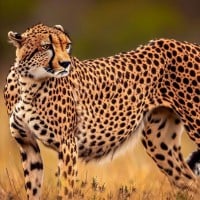 The cheetah (Acinonyx jubatus) is a large cat and native to Africa and central Iran. It is the fastest land animal, estimated to be capable of running at 80 to 128 km/h (50 to 80 mph) with the fastest reliably recorded speeds being 93 and 98 km/h (58 and 61 mph), and as such has several adaptations for speed, including a light build, long thin legs and a long tail. It typically reaches 67–94 cm (26–37 in) at the shoulder, and the head-and-body length is between 1.1 and 1.5 m (3 ft 7 in and 4 ft 11 in). Adults weigh between 21 and 72 kg (46 and 159 lb). Its head is small and rounded, and has a short snout and black tear-like facial streaks. The coat is typically tawny to creamy white or pale ...read more.
The cheetah (Acinonyx jubatus) is a large cat and native to Africa and central Iran. It is the fastest land animal, estimated to be capable of running at 80 to 128 km/h (50 to 80 mph) with the fastest reliably recorded speeds being 93 and 98 km/h (58 and 61 mph), and as such has several adaptations for speed, including a light build, long thin legs and a long tail. It typically reaches 67–94 cm (26–37 in) at the shoulder, and the head-and-body length is between 1.1 and 1.5 m (3 ft 7 in and 4 ft 11 in). Adults weigh between 21 and 72 kg (46 and 159 lb). Its head is small and rounded, and has a short snout and black tear-like facial streaks. The coat is typically tawny to creamy white or pale ...read more.
 The cheetah (Acinonyx jubatus) is a large cat and native to Africa and central Iran. It is the fastest land animal, estimated to be capable of running at 80 to 128 km/h (50 to 80 mph) with the fastest reliably recorded speeds being 93 and 98 km/h (58 and 61 mph), and as such has several adaptations for speed, including a light build, long thin legs and a long tail. It typically reaches 67–94 cm (26–37 in) at the shoulder, and the head-and-body length is between 1.1 and 1.5 m (3 ft 7 in and 4 ft 11 in). Adults weigh between 21 and 72 kg (46 and 159 lb). Its head is small and rounded, and has a short snout and black tear-like facial streaks. The coat is typically tawny to creamy white or pale ...read more.
The cheetah (Acinonyx jubatus) is a large cat and native to Africa and central Iran. It is the fastest land animal, estimated to be capable of running at 80 to 128 km/h (50 to 80 mph) with the fastest reliably recorded speeds being 93 and 98 km/h (58 and 61 mph), and as such has several adaptations for speed, including a light build, long thin legs and a long tail. It typically reaches 67–94 cm (26–37 in) at the shoulder, and the head-and-body length is between 1.1 and 1.5 m (3 ft 7 in and 4 ft 11 in). Adults weigh between 21 and 72 kg (46 and 159 lb). Its head is small and rounded, and has a short snout and black tear-like facial streaks. The coat is typically tawny to creamy white or pale ...read more. The cheetah is shy and will run away if its threatened. It will attack sometimes, especially if any predator is near its cub. This cat is also smart, and one of the smartest. They know what to use their speed for, not for racing with humans, for hunting. They have great styles for hunting too.
2 Snow Leopards
 The snow leopard (Panthera uncia), also known as the ounce, is a felid in the genus Panthera native to the mountain ranges of Central and South Asia. It is listed as Vulnerable on the IUCN Red List because the global population is estimated to number fewer than 10,000 mature individuals and is expected to decline about 10% by 2040. It is threatened by poaching and habitat destruction following infrastructural developments. It inhabits alpine and subalpine zones at elevations of 3,000–4,500 m (9,800–14,800 ft), ranging from eastern Afghanistan, the Himalayas and the Tibetan Plateau to southern Siberia, Mongolia and western China. In the northern part of its range, it also lives at lower elevations. ...read more.
The snow leopard (Panthera uncia), also known as the ounce, is a felid in the genus Panthera native to the mountain ranges of Central and South Asia. It is listed as Vulnerable on the IUCN Red List because the global population is estimated to number fewer than 10,000 mature individuals and is expected to decline about 10% by 2040. It is threatened by poaching and habitat destruction following infrastructural developments. It inhabits alpine and subalpine zones at elevations of 3,000–4,500 m (9,800–14,800 ft), ranging from eastern Afghanistan, the Himalayas and the Tibetan Plateau to southern Siberia, Mongolia and western China. In the northern part of its range, it also lives at lower elevations. ...read more.
 The snow leopard (Panthera uncia), also known as the ounce, is a felid in the genus Panthera native to the mountain ranges of Central and South Asia. It is listed as Vulnerable on the IUCN Red List because the global population is estimated to number fewer than 10,000 mature individuals and is expected to decline about 10% by 2040. It is threatened by poaching and habitat destruction following infrastructural developments. It inhabits alpine and subalpine zones at elevations of 3,000–4,500 m (9,800–14,800 ft), ranging from eastern Afghanistan, the Himalayas and the Tibetan Plateau to southern Siberia, Mongolia and western China. In the northern part of its range, it also lives at lower elevations. ...read more.
The snow leopard (Panthera uncia), also known as the ounce, is a felid in the genus Panthera native to the mountain ranges of Central and South Asia. It is listed as Vulnerable on the IUCN Red List because the global population is estimated to number fewer than 10,000 mature individuals and is expected to decline about 10% by 2040. It is threatened by poaching and habitat destruction following infrastructural developments. It inhabits alpine and subalpine zones at elevations of 3,000–4,500 m (9,800–14,800 ft), ranging from eastern Afghanistan, the Himalayas and the Tibetan Plateau to southern Siberia, Mongolia and western China. In the northern part of its range, it also lives at lower elevations. ...read more. This cat is commonly scared of humans.
3 Amur Leopard
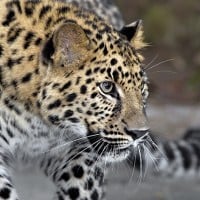 Found in the Russian Far East and parts of China, this leopard subspecies is critically endangered with only a few dozen individuals remaining in the wild. It is known for its distinctive spotted coat, which is paler than that of other leopards. It is a solitary animal, mainly preying on deer and small mammals.
Found in the Russian Far East and parts of China, this leopard subspecies is critically endangered with only a few dozen individuals remaining in the wild. It is known for its distinctive spotted coat, which is paler than that of other leopards. It is a solitary animal, mainly preying on deer and small mammals.
 Found in the Russian Far East and parts of China, this leopard subspecies is critically endangered with only a few dozen individuals remaining in the wild. It is known for its distinctive spotted coat, which is paler than that of other leopards. It is a solitary animal, mainly preying on deer and small mammals.
Found in the Russian Far East and parts of China, this leopard subspecies is critically endangered with only a few dozen individuals remaining in the wild. It is known for its distinctive spotted coat, which is paler than that of other leopards. It is a solitary animal, mainly preying on deer and small mammals. These are almost extinct, they are very rare and shy. They most likely to avoid people, if seen.
4 Jaguars
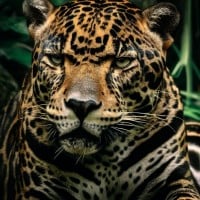 The jaguar (Panthera onca) is a large cat species and the only living member of the genus Panthera native to the Americas. With a body length of up to 1.85 m (6 ft 1 in) and a weight of up to 158 kg (348 lb), it is the largest cat species in the Americas and the third largest in the world. Its distinctively marked coat features pale yellow to tan colored fur covered by spots that transition to rosettes on the sides, although a melanistic black coat appears in some individuals. The jaguar's powerful bite allows it to pierce the carapaces of turtles and tortoises, and to employ an unusual killing method: it bites directly through the skull of mammalian prey between the ears to deliver a fatal ...read more.
The jaguar (Panthera onca) is a large cat species and the only living member of the genus Panthera native to the Americas. With a body length of up to 1.85 m (6 ft 1 in) and a weight of up to 158 kg (348 lb), it is the largest cat species in the Americas and the third largest in the world. Its distinctively marked coat features pale yellow to tan colored fur covered by spots that transition to rosettes on the sides, although a melanistic black coat appears in some individuals. The jaguar's powerful bite allows it to pierce the carapaces of turtles and tortoises, and to employ an unusual killing method: it bites directly through the skull of mammalian prey between the ears to deliver a fatal ...read more.
 The jaguar (Panthera onca) is a large cat species and the only living member of the genus Panthera native to the Americas. With a body length of up to 1.85 m (6 ft 1 in) and a weight of up to 158 kg (348 lb), it is the largest cat species in the Americas and the third largest in the world. Its distinctively marked coat features pale yellow to tan colored fur covered by spots that transition to rosettes on the sides, although a melanistic black coat appears in some individuals. The jaguar's powerful bite allows it to pierce the carapaces of turtles and tortoises, and to employ an unusual killing method: it bites directly through the skull of mammalian prey between the ears to deliver a fatal ...read more.
The jaguar (Panthera onca) is a large cat species and the only living member of the genus Panthera native to the Americas. With a body length of up to 1.85 m (6 ft 1 in) and a weight of up to 158 kg (348 lb), it is the largest cat species in the Americas and the third largest in the world. Its distinctively marked coat features pale yellow to tan colored fur covered by spots that transition to rosettes on the sides, although a melanistic black coat appears in some individuals. The jaguar's powerful bite allows it to pierce the carapaces of turtles and tortoises, and to employ an unusual killing method: it bites directly through the skull of mammalian prey between the ears to deliver a fatal ...read more. They are one of the smartest cats, they also can easily kill you, probably if threatened. They are also very strong.
Probably one of my favorite besides lions
5 Servals
 The serval is a medium-sized wild cat native to Africa. It is recognized for its distinctive coat, featuring a tawny background with bold black spots and stripes. Servals have a slender body, long legs, and large ears with excellent hearing capabilities. They are adapted to a semi-aquatic lifestyle, often found near wetlands or marshes. Servals are skilled hunters, preying on a variety of small animals like rodents, birds, and amphibians. They are known for their unique hunting technique of leaping into the air to catch birds in flight. Despite their striking appearance, servals are elusive creatures that are rarely seen in the wild.
The serval is a medium-sized wild cat native to Africa. It is recognized for its distinctive coat, featuring a tawny background with bold black spots and stripes. Servals have a slender body, long legs, and large ears with excellent hearing capabilities. They are adapted to a semi-aquatic lifestyle, often found near wetlands or marshes. Servals are skilled hunters, preying on a variety of small animals like rodents, birds, and amphibians. They are known for their unique hunting technique of leaping into the air to catch birds in flight. Despite their striking appearance, servals are elusive creatures that are rarely seen in the wild.
 The serval is a medium-sized wild cat native to Africa. It is recognized for its distinctive coat, featuring a tawny background with bold black spots and stripes. Servals have a slender body, long legs, and large ears with excellent hearing capabilities. They are adapted to a semi-aquatic lifestyle, often found near wetlands or marshes. Servals are skilled hunters, preying on a variety of small animals like rodents, birds, and amphibians. They are known for their unique hunting technique of leaping into the air to catch birds in flight. Despite their striking appearance, servals are elusive creatures that are rarely seen in the wild.
The serval is a medium-sized wild cat native to Africa. It is recognized for its distinctive coat, featuring a tawny background with bold black spots and stripes. Servals have a slender body, long legs, and large ears with excellent hearing capabilities. They are adapted to a semi-aquatic lifestyle, often found near wetlands or marshes. Servals are skilled hunters, preying on a variety of small animals like rodents, birds, and amphibians. They are known for their unique hunting technique of leaping into the air to catch birds in flight. Despite their striking appearance, servals are elusive creatures that are rarely seen in the wild.
6 Lion
 The lion (Panthera leo) is a large cat of the genus Panthera native to Africa and India. It has a muscular, broad-chested body, short, rounded head, round ears, and a hairy tuft at the end of its tail. It is sexually dimorphic; adult male lions are larger than females and have a prominent mane. It is a social species, forming groups called prides. A lion's pride consists of a few adult males, related females, and cubs. Groups of female lions usually hunt together, preying mostly on large ungulates. The lion is an apex and keystone predator; although some lions scavenge when opportunities occur and have been known to hunt humans, the species typically does not actively seek out and prey on humans. ...read more.
The lion (Panthera leo) is a large cat of the genus Panthera native to Africa and India. It has a muscular, broad-chested body, short, rounded head, round ears, and a hairy tuft at the end of its tail. It is sexually dimorphic; adult male lions are larger than females and have a prominent mane. It is a social species, forming groups called prides. A lion's pride consists of a few adult males, related females, and cubs. Groups of female lions usually hunt together, preying mostly on large ungulates. The lion is an apex and keystone predator; although some lions scavenge when opportunities occur and have been known to hunt humans, the species typically does not actively seek out and prey on humans. ...read more.
 The lion (Panthera leo) is a large cat of the genus Panthera native to Africa and India. It has a muscular, broad-chested body, short, rounded head, round ears, and a hairy tuft at the end of its tail. It is sexually dimorphic; adult male lions are larger than females and have a prominent mane. It is a social species, forming groups called prides. A lion's pride consists of a few adult males, related females, and cubs. Groups of female lions usually hunt together, preying mostly on large ungulates. The lion is an apex and keystone predator; although some lions scavenge when opportunities occur and have been known to hunt humans, the species typically does not actively seek out and prey on humans. ...read more.
The lion (Panthera leo) is a large cat of the genus Panthera native to Africa and India. It has a muscular, broad-chested body, short, rounded head, round ears, and a hairy tuft at the end of its tail. It is sexually dimorphic; adult male lions are larger than females and have a prominent mane. It is a social species, forming groups called prides. A lion's pride consists of a few adult males, related females, and cubs. Groups of female lions usually hunt together, preying mostly on large ungulates. The lion is an apex and keystone predator; although some lions scavenge when opportunities occur and have been known to hunt humans, the species typically does not actively seek out and prey on humans. ...read more.
7 Cougar
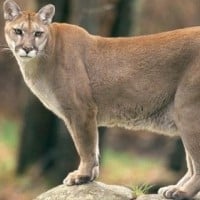 The cougar, also commonly known as the mountain lion, puma, panther, or catamount, is a large felid of the subfamily Felinae native to the Americas.
The cougar, also commonly known as the mountain lion, puma, panther, or catamount, is a large felid of the subfamily Felinae native to the Americas.
 The cougar, also commonly known as the mountain lion, puma, panther, or catamount, is a large felid of the subfamily Felinae native to the Americas.
The cougar, also commonly known as the mountain lion, puma, panther, or catamount, is a large felid of the subfamily Felinae native to the Americas.
8 Clouded Leopard
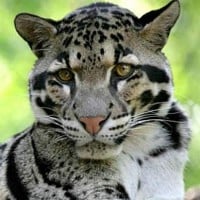 Native to the foothills of the Himalayas and parts of China and Southeast Asia, the Clouded Leopard is known for its beautiful cloud-like spots on its coat. It's an agile climber and spends much of its time in trees. It preys on a variety of animals including small mammals and birds.
Native to the foothills of the Himalayas and parts of China and Southeast Asia, the Clouded Leopard is known for its beautiful cloud-like spots on its coat. It's an agile climber and spends much of its time in trees. It preys on a variety of animals including small mammals and birds.
 Native to the foothills of the Himalayas and parts of China and Southeast Asia, the Clouded Leopard is known for its beautiful cloud-like spots on its coat. It's an agile climber and spends much of its time in trees. It preys on a variety of animals including small mammals and birds.
Native to the foothills of the Himalayas and parts of China and Southeast Asia, the Clouded Leopard is known for its beautiful cloud-like spots on its coat. It's an agile climber and spends much of its time in trees. It preys on a variety of animals including small mammals and birds.
9 Panther
10 Tiger
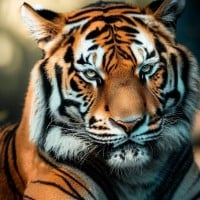 The tiger (Panthera tigris) is the largest living cat species and a member of the genus Panthera. It is most recognisable for its dark vertical stripes on orange fur with a white underside. An apex predator, it primarily preys on ungulates such as deer and wild boar. It is territorial and generally a solitary but social predator, requiring large contiguous areas of habitat, which support its requirements for prey and rearing of its offspring. Tiger cubs stay with their mother for about two years, then become independent and leave their mother's home range to establish their own. ...read more.
The tiger (Panthera tigris) is the largest living cat species and a member of the genus Panthera. It is most recognisable for its dark vertical stripes on orange fur with a white underside. An apex predator, it primarily preys on ungulates such as deer and wild boar. It is territorial and generally a solitary but social predator, requiring large contiguous areas of habitat, which support its requirements for prey and rearing of its offspring. Tiger cubs stay with their mother for about two years, then become independent and leave their mother's home range to establish their own. ...read more.
 The tiger (Panthera tigris) is the largest living cat species and a member of the genus Panthera. It is most recognisable for its dark vertical stripes on orange fur with a white underside. An apex predator, it primarily preys on ungulates such as deer and wild boar. It is territorial and generally a solitary but social predator, requiring large contiguous areas of habitat, which support its requirements for prey and rearing of its offspring. Tiger cubs stay with their mother for about two years, then become independent and leave their mother's home range to establish their own. ...read more.
The tiger (Panthera tigris) is the largest living cat species and a member of the genus Panthera. It is most recognisable for its dark vertical stripes on orange fur with a white underside. An apex predator, it primarily preys on ungulates such as deer and wild boar. It is territorial and generally a solitary but social predator, requiring large contiguous areas of habitat, which support its requirements for prey and rearing of its offspring. Tiger cubs stay with their mother for about two years, then become independent and leave their mother's home range to establish their own. ...read more.The Contenders
11 Siamese
 The Siamese cat is one of the first distinctly recognized breeds of Asian cat. Derived from the rtgs: wichianmat landrace, one of several varieties of cat native to Thailand, the Siamese became one of the most popular breeds in Europe and North America in the 20th century.
The Siamese cat is one of the first distinctly recognized breeds of Asian cat. Derived from the rtgs: wichianmat landrace, one of several varieties of cat native to Thailand, the Siamese became one of the most popular breeds in Europe and North America in the 20th century.
 The Siamese cat is one of the first distinctly recognized breeds of Asian cat. Derived from the rtgs: wichianmat landrace, one of several varieties of cat native to Thailand, the Siamese became one of the most popular breeds in Europe and North America in the 20th century.
The Siamese cat is one of the first distinctly recognized breeds of Asian cat. Derived from the rtgs: wichianmat landrace, one of several varieties of cat native to Thailand, the Siamese became one of the most popular breeds in Europe and North America in the 20th century.BAdd New Item